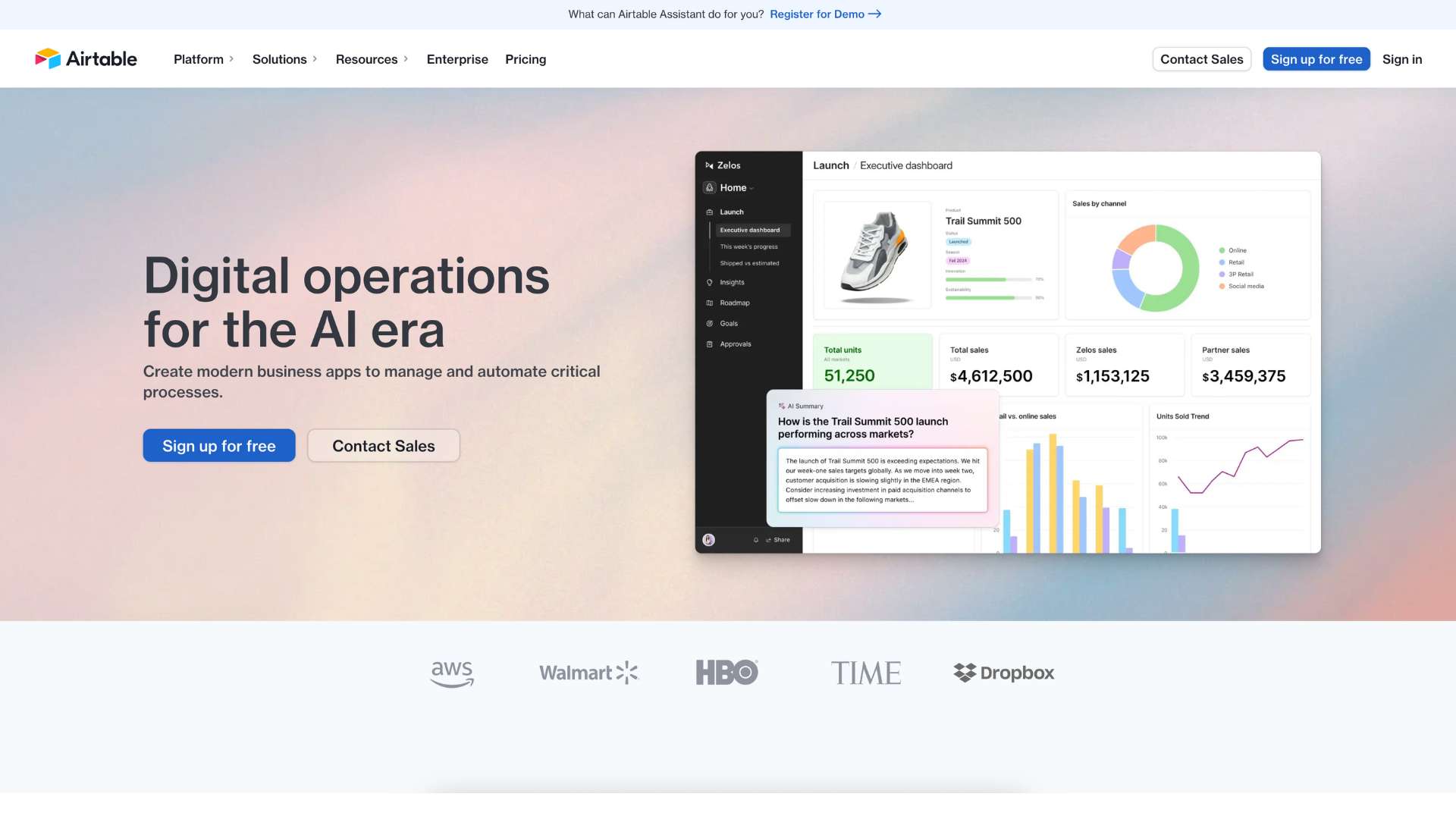Airtable Review (2025): Features, Pricing, Pros & Cons
Airtable is a cloud-based platform that combines the familiarity of spreadsheets with the functionality of databases. It empowers teams to build custom applications without writing code, facilitating the organization of work, data management, and workflow streamlining across various departments.
Airtable addresses the limitations of rigid project management tools and chaotic spreadsheets by providing an all-in-one, customizable workspace for project tracking, content calendars, CRM, inventory management, and more.
Ideal for project managers, marketers, content teams, product developers, HR professionals, nonprofits, and small to medium-sized businesses, Airtable offers visual, collaborative, and customizable tools without the need for developers.
Company Background
- Founders: Howie Liu, Andrew Ofstad, and Emmett Nicholas
- Founded: 2012
- Headquarters: San Francisco, California
- Website: https://airtable.com
Airtable was conceived with the vision of democratizing software creation. CEO Howie Liu, previously the founder of Etacts (acquired by Salesforce), aimed to empower non-developers to build tools tailored to their workflows.
What began as a user-friendly database alternative has evolved into a robust platform trusted by over 300,000 organizations, including Netflix, Shopify, and Time Magazine.
Key Features
Data Management and Views
| Feature | Description | Benefit |
|---|---|---|
| Grid View | Spreadsheet-like interface | Familiar UI for ease of use |
| Kanban View | Visual task cards | Ideal for agile teams or marketing |
| Calendar View | Date-based layout | Perfect for editorial calendars |
| Gallery View | Visual cards with images | Useful for creative teams |
| Gantt View | Timeline-based project tracking | Powerful for product and operations planning |
Collaboration Tools
- Real-time collaboration and commenting
- Task assignments, permission settings, and shared views
- Automated notifications and reminders
Automations
- Create triggers and actions across tables
- Integrate with Slack, Gmail, Google Calendar, and more
- Reduce manual work through logic-based automation
Interface Designer
- Drag-and-drop dashboard builder for custom internal tools
- Role-based UI tailored to each team’s needs
- No-code user interfaces powered by Airtable bases
Integrations
- Native integrations: Slack, Gmail, Dropbox, Google Drive, Notion
- 1000+ apps via Zapier or Make (Integromat)
- Airtable API for developers requiring deep integrations
Advanced Field Types
- Attachments, long text, barcodes, formulas, linked tables
- Rich data flexibility allows complex records and workflows
Sync & External Sources
- Sync data across bases or from external sources like Salesforce, Jira, or CSVs
- Maintain a single source of truth for cross-team reporting
Templates & Extensions
- 100+ free templates (Content Calendar, Bug Tracker, Applicant Tracker, etc.)
- Extensions for charts, maps, email sending, and more
User Interface and Experience (UI/UX)
- Design Quality: Clean, intuitive interface combining the familiarity of Excel with the visual appeal of Trello or Asana
- Onboarding: Interactive tutorials, in-app guides, and helpful templates facilitate easy onboarding for non-technical users
- Customization: Color-coded records, grouped views, filters, and personal dashboards enhance usability
- Mobile Experience: Available on iOS and Android with offline viewing and light editing capabilities; some limitations in field types and views compared to desktop
- Accessibility: WCAG-compliant options, keyboard navigation, and screen-reader support are available but not yet perfect
Platforms Supported
| Platform | Availability |
|---|---|
| Web-based | ✅ Fully featured |
| Windows/macOS | ✅ Via browser |
| Mobile | ✅ iOS & Android apps |
| Cloud Storage | ✅ Fully cloud-based |
| Offline Access | ⚠️ Limited (read-only on mobile) |
| Local Installation | ❌ Not supported |
Pricing
Current Pricing Plans (2025)
| Plan | Price | Best For | Key Features |
|---|---|---|---|
| Free | $0 | Personal use, small projects | Unlimited bases, 1,000 records/base, 1 app per base |
| Team | $20/user/month (annually) | Small teams | 50,000 records/base, Gantt & Timeline Views, 25,000 automation runs/month |
| Business | $45/user/month (annually) | Growing teams & SMBs | 125,000 records/base, advanced permissions, SAML SSO, 100,000 automation runs/month |
| Enterprise Scale | Custom pricing | Large enterprises | Admin panel, unlimited workspaces, advanced integrations, dedicated CSM |
- Free trial: 14-day trial of Team plan features
- Billing: Monthly and annual billing options available
Pros and Cons
Pros
- Highly customizable with no coding required
- Multiple views make data more actionable and visual
- Interface Designer allows building internal tools without developers
- Extensive library of templates and automation triggers
- Scalable from personal use to enterprise deployment
Cons
- Advanced features (e.g., syncing, interfaces) are gated behind higher pricing tiers
- Limited offline capabilities
- Formula and linked record setup can be complex for new users
- Mobile app has limited functionality for complex tasks
Customer Support and Resources
| Channel | Availability |
|---|---|
| Help Center | ✅ 24/7 searchable knowledge base |
| Email Support | ✅ Business hours |
| Live Chat | ✅ For paid plans |
| Community Forum | ✅ Active Airtable Community |
| Tutorials & Videos | ✅ Airtable Universe, YouTube walkthroughs |
| Onboarding Support | ✅ For Business & Enterprise tiers |
- Help Center Quality: Clear documentation, categorized by topic and use case
- Airtable Universe: A curated library of templates shared by users and companies
- Developer Docs: Comprehensive API documentation and SDKs
Real-World Use Cases / Ideal Users
- Marketing Teams: Utilize Airtable for campaign planning, content calendars, asset management, and creative review workflows. Its visual layouts and deadlines make it ideal for keeping creatives on track.
- Startups and Product Teams: Track product roadmaps, bug reports, and customer feedback with Gantt or Kanban views. Interfaces help present data differently for PMs, engineers, or executives.
- Agencies and Freelancers: Build lightweight CRMs, project trackers, or invoice systems that look professional and are easy to maintain—no development resources required.
- Enterprise Operations: Use as a database for operations, HR, or procurement workflows. With SSO, admin controls, and audit logs, Airtable supports enterprise-grade compliance.
User Reviews and Ratings
| Platform | Rating (2025) | Highlights |
|---|---|---|
| G2 | 4.6/5 | Praise for flexibility and collaboration |
| Capterra | 4.7/5 | High marks for ease of use |
| Trustpilot | 4.4/5 | Users highlight responsive customer support |
| Product Hunt | 4.8/5 | Loved by tech-savvy and no-code creators |
“Airtable transformed the way our team handles data—it’s like Excel and Trello had a smarter baby.” – Sophia C., Content Lead at Startup
Best Alternatives
| Software | Best For | Key Difference |
|---|---|---|
| Notion | Note-taking + database hybrid | Better for docs and internal wikis |
| Asana | Task/project management | More structured task-focused workflows |
| ClickUp | All-in-one productivity | Combines task, doc, and goal tracking |
| Trello | Simpler Kanban boards | Lacks Airtable’s database and view variety |
| Smartsheet | Enterprise-grade spreadsheets | More robust for traditional project planning |
Summary
Airtable continues to lead the no-code productivity space by offering an intuitive, highly visual, and modular platform that empowers teams to build their own tools. From personal projects to enterprise-level applications, its flexibility is unmatched, though some powerful features come at a cost.
If you’re seeking a scalable solution that can evolve from a simple tracker to a full-fledged internal tool builder, Airtable is worth exploring.
Visit Airtable’s official site or compare more software reviews at usefully.site.
Media
Airtable Tutorial: A-Z Guide [2025]
How We Organize & Manage Social Media Content with Airtable (Team Workflow Revealed!)


